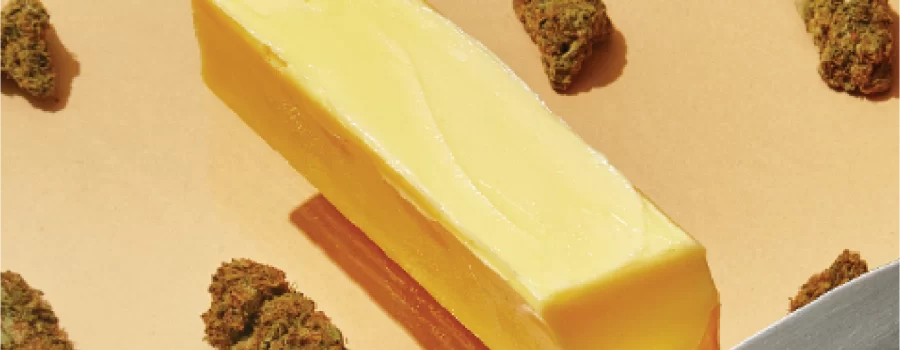This guide to making cannabutter is adapted from ‘The Art of Weed Butter’ by Mennlay Golokeh Aggrey, with further reporting by Zoe Denenberg.
Cannabutter can transform brownie batter, cookie dough, or just about any recipe into a batch of homemade edibles—and you don’t have to be a master chef or cannabis connoisseur to make it. All you need to make cannabis into butter is patience, organization, a reliable recipe, and some understanding of dosing. Following the same method, you can also make infused chili crisp to drizzle on noodles or elevated coconut oil to coat kettle corn. The following cannabutter recipe loosely translates into 30 mg of THC per tablespoon of oil or butter. Your perfect dose will vary, but 10 mg is standard. Start by testing ¼ tsp. of the weed butter you make and wait for about an hour. (If this is your first time experimenting with edibles, note that the effects take longer to set in than when inhaling.) Take note of how you feel and let your body tell you whether this is a good amount, or if you need more or less. Erring on the side of caution will ensure that you have a positive experience.
STEP 1: DECARBOXYLATION
When making cannabutter, the first step is to decarboxylate your cannabis. Also known as “decarbing,” baking the cannabis flower transforms the inactive cannabinoids (THCA and CBDA) into their active counterparts (THC and CBD). This unlocks their psychoactive effects and also allows the lipids in butter and oil to easily bind to your cannabis for the best cannabis infusion. Whether you prefer indica or sativa, it’s best to use whole cannabis flowers, broken up into large nuggets, not ground cannabis—unless you want a flurry of cannabis snowflakes flying around inside your oven (spoiler alert: you don’t). You’ll break up the decarbed flower with a hand grinder after baking.
What You’ll Need
½ oz cannabis flower
Parchment paper
Glass baking dish or sheet pan
Hand grinder or scissors
Preparation
Preheat the oven to 220°F. Gently break the buds into large pieces and evenly spread the plant material onto a parchment-lined baking sheet. Slide it onto the center rack of the oven and bake for 20 minutes if using old or lower-quality weed; 45 minutes for cured, high-grade weed; or 1 hour or more for anything that has been recently harvested and is still wet. Check on the weed frequently while it’s in the oven, gently mixing it every 10 minutes so as to not burn it. You will notice that the color of your herb will change from bright green to a deep brownish-green. That’s when you know it has decarboxylated. Remove the weed from the oven and allow it to cool on the baking sheet. Once it has cooled, break up the decarbed weed using a hand grinder, scissors, or with hands until it’s the perfect consistency for rolling a joint—fine, but not too fine. Anything too fine will slip through cheesecloth (or a joint, for that matter), murking up your butter. You want your cannabutter to be as clean and clear as possible.
STEP 2: STOVETOP INFUSION
The next step of the process is more time intensive: A cooking time of roughly 4 hours allows the cannabis to fully infuse into the fat of your choice. While infusing weed in butter or ghee is a popular technique, you can infuse decarbed cannabis into any fat—such as olive oil, sesame oil, or coconut oil—and the infusion process is the same no matter which type of fat you choose. If you do want to make weed butter, we recommend using unsalted butter so you’re able to control the salt level of the final product. The longer the melted butter and cannabis simmer together, the more potent your cannabutter will be. We opt for a four-hour infusion here, which delivers just enough potency and a grassy but not overpowering flavor. Adding water to the pot prevents the cannabutter from scalding, eliminating the need for a double boiler. As long as you keep the saucepan on very low heat (and watch the pot), it’s not likely to burn—though it may perfume your kitchen with a certain, ahem, aroma. (That’s thanks to the terpenes, a.k.a. the aromatic compounds responsible for cannabis’s signature smell.) If you’re still concerned about scalding or want a more discreet, hands-off approach, you can also cook weed butter in a slow cooker set to the lowest setting.
Ingredients
1½ cups water
8 oz. clarified butter, unsalted butter, or oil
½ oz. decarboxylated cannabis
Medium saucepan Wooden spoon
Thermometer
Cheesecloth and/or mesh strainer
Preparation
- In a medium saucepan on very low heat, add water and butter or oil.
- If using butter, wait for it to melt, then add the ground decarboxylated cannabis.
- Mix well with a wooden spoon and cover with lid.
- Simmer gently for 4 hours, stirring every half hour to make sure the butter isn’t burning. If you have a kitchen thermometer, check to make sure the temperature doesn’t reach above 180°F.
- After 4 hours, strain with cheesecloth or mesh strainer into a container.
- Let the butter cool to room temperature.
- Use immediately, or store in an airtight container (a well-sealed mason jar will work) in the refrigerator or freezer for up to six months.


